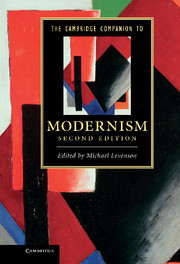Book contents
- Frontmatter
- Introduction
- 1 The metaphysics of Modernism
- 2 The cultural economy of Modernism
- 3 The Modernist novel
- 4 Modern poetry
- 5 Modernism in drama
- 6 Modernism and the politics of culture
- 7 Modernism and religion
- 8 Modernism and mass culture
- 9 Modernism and gender
- 10 Musical motives in Modernism
- 11 Modernism and the visual arts
- 12 Modernism and film
- 13 Modernism and colonialism
- Further reading
- Index
4 - Modern poetry
Published online by Cambridge University Press: 28 September 2011
- Frontmatter
- Introduction
- 1 The metaphysics of Modernism
- 2 The cultural economy of Modernism
- 3 The Modernist novel
- 4 Modern poetry
- 5 Modernism in drama
- 6 Modernism and the politics of culture
- 7 Modernism and religion
- 8 Modernism and mass culture
- 9 Modernism and gender
- 10 Musical motives in Modernism
- 11 Modernism and the visual arts
- 12 Modernism and film
- 13 Modernism and colonialism
- Further reading
- Index
Summary
Not long ago, modern poetry - Yeats, Pound, Eliot, Stevens - seemed to occupy an enormous territory on the literary-historical map. But as the twentieth century comes to an end, the Modernism that once loomed so large now seems startlingly diminished. Beginning in the late 1950s, critics began to see through the smoke screen of New Critical antiromanticism, uncovering the important affiliations between romantic, Victorian, and modern poetics. Today, in the wake of pioneering work by Frank Kermode, Robert Langbaum, and especially Harold Bloom, Eliot not only seems indebted to Tennyson; his Modernism makes most sense when we understand it as part of a continuum beginning with the publication of the Lyrical Ballads.
And if the historical integrity of Modernism has been encroached on by romanticism, an increasingly powerful postmodernism has exerted equal pressure from the opposite side. Certain modern poets - for Marjorie Perloff, Pound but not Stevens - are claimed as proto-postmodernists, leaving the impression that the remaining Modernists are a hapless, ineffectual lot. And what makes this remapping of the moderns all the more complicated is that the various cartographers narrow the Modernist field in different ways. For some, Stevens is in while Pound is out; for others, H. D. or Gwendolyn Brooks hold our attention at the expense of both Stevens and Pound.
- Type
- Chapter
- Information
- The Cambridge Companion to Modernism , pp. 99 - 127Publisher: Cambridge University PressPrint publication year: 2011
- 1
- Cited by

